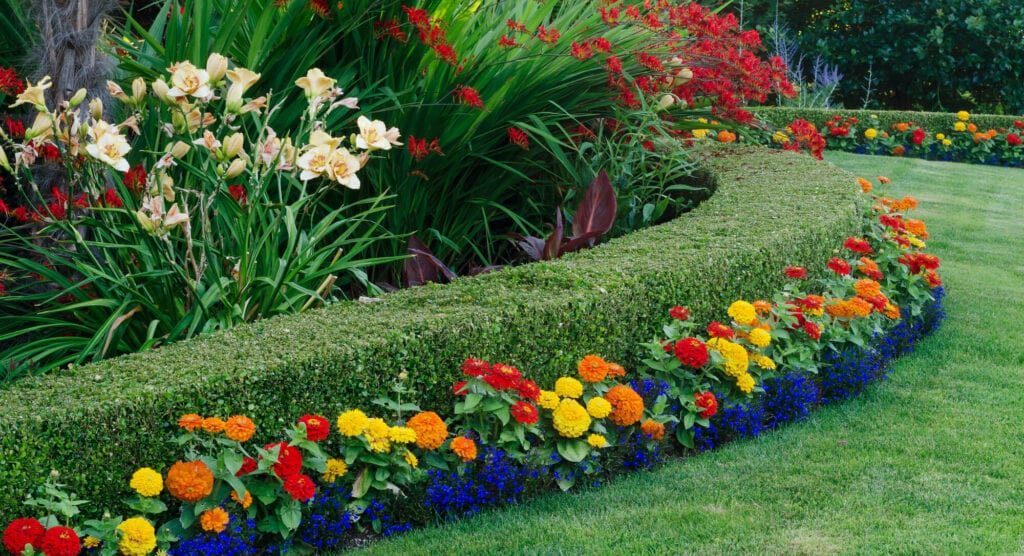
Landscape architects and horticulturists can tell at a glance whether landscaping plantings and beds are maintained by professionals who know the timeless practices that never go out of style. Once you get to know them, you’ll have that same eye that master gardeners and professionals share.
Plan For Low Maintenance To Get It
Nobody wants landscaping that requires excessive care, but you must accept that every landscape requires regular care. When one acknowledges this and commits to giving their landscaping the minimum necessary care on a regular basis, they will be rewarded with reduced maintenance over the long run.
To minimize the work of landscape maintenance, it is imperative to start with a solid foundation. This includes a design that organizes plants for a beautiful display while also respecting their horticultural requirements. It also demands that before those plants are installed, there is a plan to provide the cultural conditions that will allow the plants to thrive, rich soil, proper drainage, and supplemental watering.
#1. Good Design Minimizes Care
Like people, plants are better together. When plants are grouped together, they enter into symbiotic relationships, often through the activities of beneficial mycorrhizae that facilitate the sharing of nutrients and moisture.
Equally important are the physical benefits of plant groups. Most gardeners are aware of the axiom of planting in groupings of odd numbers of three, five, or more. The visual appeal of groupings is that it amplifies their attributes, which may be flowering, bold green foliage, or the impact of fall color.
When plants are grouped in this way, they shade the soil beneath to conserve moisture and minimize obnoxious weeds. Thus, good landscape design is good for plant care too.
#2. Bed Preparation Is Vital
Planting beds with rich, loamy soils naturally support plantings and the ecosystem of microbes, fungi, and the like that are part of it. For this reason, it’s wise to replace the top 6-8″ of soil in planting beds with fresh topsoil to establish that essential foundation.
This is also an invaluable renewal practice to renew planting beds. This can be a little tricky with existing plantings, especially trees. However, pruning away tender feeder roots at the surface to replace the soil can be a beneficial practice. If the soil is tired, its likely roots are too. Carefully trimming them back and adding new topsoil can literally jumpstart their growth.
#3. Proper Installation Enhances Success
When planting trees, shrubs, and even perennials, you will have greater success by ensuring they are at the correct elevation, not too high or low. Getting this right comes from experience, knowing how much the plant will settle into the disturbed soil.
This should be monitored during the first month or so of planting. Plants may settle and shift due to the effects of high winds before they have rooted themselves. It’s a simple matter to raise the level of plants with shovels and additional soil.
If plants are too shallow, it’s best to remove them and dig the holes deeper. If this is not possible, in the case of larger trees or shrubs, for example, it’s best to carve away the bottom portion of the root ball. This may seem to be an aggressive technique, but it isn’t, because the surface roots are the most important for getting the plant reestablished.
#4. Hardwood Mulching Is Protective
The gold standard for mulch has always been shredded hardwood bark. This product decomposes and breaks down slowly, has an attractive appearance, and functionally works to minimize moisture and temperature fluctuations at the surface.
Apply 2-4″ of mulch to the surface around each plant, being careful not to pile it high against the trunk, as this will encourage rotting of the bark and detrimental bacterial growth. Nowadays, there are many types of wood mulch products. If you are using one that is not predominantly bark, be sure that it has been sufficiently cured or seasoned to allow for harmful chemicals to leach out of it.

#5. Periodic Cultivation Helps Soils Breathe
Professional landscape maintenance services should lightly cultivate the mulch and surface soil with rakes to loosen it. This allows for oxygen to freely pass to the root systems. Heavier clay soils will benefit the most from this practice.
Here in Minnesota, bed cultivation is typically not needed in the springtime because, after a winter of free-thaw cycles, the soils have self-cultivated. Late summer is probably the best time for this practice because temperatures have decreased and moisture is more plentiful.
#6. Drainage Management Is Life-Sustaining
Soils that do not properly drain are starved for oxygen. Water literally squeezes oxygen out of even the smallest air pockets. If remedial measures are not taken within a few days or weeks at the most, the plants will begin their inevitable decline.
Natural drainage is accomplished by the pitch of the land. Over years and years of erosion, natural areas such as forests have carved out these escape routes for excessive moisture. In residential environments, it may be necessary to install sub-service drainage measures that will carry off the water more rapidly.
Consider these systems investments in the longevity of your landscape plants, as they may only be needed a few times each year, but that’s enough to merit their use.
#7. Automatic Irrigation Systems Are Helpful
Insufficient moisture is just as harmful as too much, maybe more so. If you can get by with hand-watering during periods of drought, that’s enough. This may be the best approach because it makes the homeowner more aware of when to water.
Irrigation systems can be life-savers when you are not home or too busy to get outside and water. Additionally, they can be used to water during the early morning hours when temperatures and winds are less likely to encourage evaporation.
The primary caution when using automatic irrigation is to avoid the impulse to “set it and forget it.” Too much irrigation can encourage diseases. It can also negate the effects of natural rainfall, washing away valuable nitrogen that is a plentiful byproduct of thunderstorms.
#8. Professional Methods Simplify Weed Control
There are three basic methods professionals use to minimize weeds. The most common are mechanical cultivation. Most contractors will also use a pre-emergent herbicide to prevent weeds from germinating in the springtime. If the practice is successful, then minor cultivation is all that’s needed.
A more aggressive technique is a broad-spectrum herbicide. These products, while available to homeowners in diluted concentrations, are best left to the experts who are licensed in their use. They will know how to use them safely to minimize the risks to people, plants, and pets.
#9. Proactive Disease Management Works
As it is with weed control, the best and safest disease control practices are mechanical.
For example, crabapple trees are susceptible to a variety of fungal diseases that are spread when contaminated leaves fall to the ground and are blown into nearby properties. Attention to raking up these leaves and removing them from the site can control or ultimately eradicate the disease from the property.
This same procedure is used to manage unsightly oak galls. Galls are growths on the leaves of oak trees that lead to the curling and disfiguring of leaves. In addition to pruning off stems with oak galls, expeditiously cleaning up fallen leaves often proves highly successful in eliminating the problem from the landscape.
Architectural Landscape Design: Helping Homeowners Enjoy Better Living
Here at ALD, our top priority is creating living spaces that are right for you. Our landscape design team will work with you from concept to construction to create the right landscape for your personal needs. Contact us today for a free consultation to explore your next outdoor living project.
